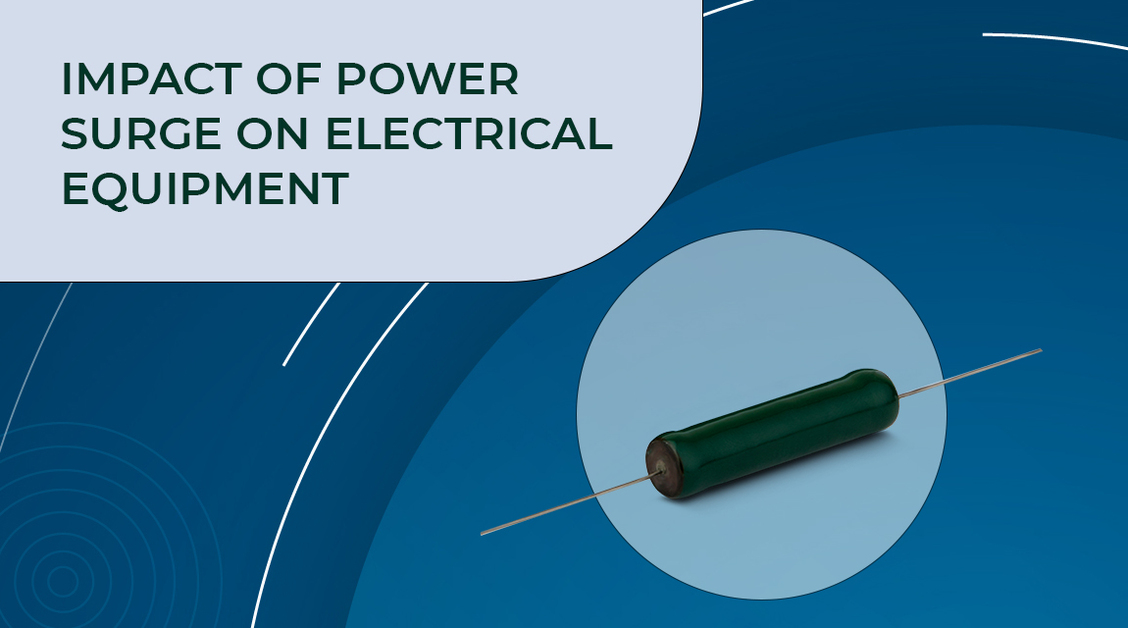
Impact of power surge on electrical equipment
Power surge is a serious and commonly occurring phenomenon that causes damage to sensitive electrical equipment and reduces their service life. We bring to you a series of Frequently Asked Questions on power surges, their causes, impact and suppression techniques.
What is Power Surge?
A surge is a transient, short duration wave of excessive current, voltage or power in an electric circuit. The surge happens when there is a brief pause in the flow of electricity and then resumes, or when electricity begins to flow back into the circuit.
Voltage surge in power lines may occur for very short durations but is very destructive as it can go as high as a few kilovolts within that short time.
The very nature of AC power supply is prone to fluctuation, unlike DC power where it can be stored and regulated. AC loads may be connected or disconnected at any time, so it is impossible to forecast exact demand. These factors add to the possibility of uneven supply and power surges.
What are the major causes of power surge?
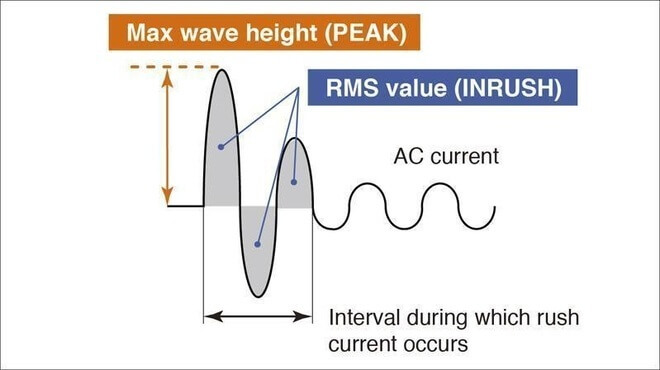
Inrush current transients during power-on of motors, transformers
Induction motors and transformers generate huge input current during start-up time (called inrush current) that can potentially damage their stator coils.
1. Natural causes:
- Lightning strikes
- Tree falling on power lines
- Birds damaging equipment
These natural causes can have an enormous effect on electrical equipment, especially because we are not prepared for it. They can cause instant failure of the devices due to excessive heating or burn out.
2. External causes:
- Power restored after a grid black out
- Surge transmitted through power cables to reach the equipment
3. Internal causes:
- Ignition of high-power devices such as motors, heavy equipment
- Poor wiring
- Overloaded circuits
- Faulty insulation
- Grounding faults
- Loose connections
- EMI discharge due to inductive coupling
- Switching of power from main supply to back-up power and vice versa
- Short Circuit
These factors may not have an immediate destructive effect. But with repeated occurrences, they can cause increased wear and tear, eventually leading to shortened service life and frequent maintenance.
When do you need surge protection?
Whether you need a surge protector or not depends on the devices you are plugging in. Surge protectors help to extend the lifespan of electric & electronic devices whether it is at home, office or industrial premises.
Low-cost, easily replaceable devices do not need surge protection, such as light bulbs or fans. Because surge protection may be more expensive than the equipment itself, in such cases! However, when it is expensive and power-sensitive equipment installed on the premises, it needs to be protected from permanent damage, component failure, and frequent wear & tear.
Laptops, telecom equipment, medical electronics instruments, power distribution panels are examples of voltage-sensitive devices, which could be easily damaged with a power surge and cause a supply breakdown. Repeated power surges would cause slow damage to devices and shorten their lifespan, which is not easy to detect. A power surge could shorten the life of a computer or even wipe out all of the data.
What are the common surge suppression techniques?
Surge protection works by setting up a preventive safety mechanism against sudden electrical excesses, such as a power surge or transient voltage. The increase in voltage may be significantly above the designated voltage ratings of equipment installed in the premises.
The surge protection device is first connected to the supply line, only then the electricity is allowed to enter the actual equipment. With the correct voltage, current flows through as normal into the equipment. But with a spike or surge, the surge protection device triggers immediately and redirects the excess.
Depending on the equipment under protection, different methods of surge protection are used, ranging from surge suppressor resistors to EMI filter circuits. Some of the common surge protection products and methods are listed below.
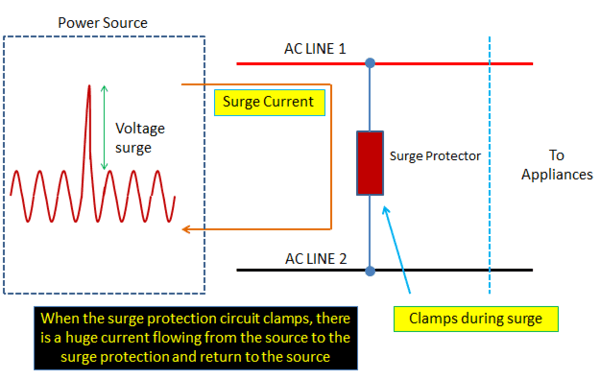
Surge Protection Circuit
Image Courtesy – http://electronicsbeliever.com/surge-protection-circuit-principle-design/
1. Surge protection / pulse-withstanding resistors – Most commonly deployed solution. Power resistors are used to dissipate excess energy from high power circuits during transient or overload conditions.
Once voltage rises above the expected level, the surge protector comes into play. It suppresses the excess voltage, diverts it safely to the ground and prevents it from causing any harm. When used together with air terminals, grounding rods, these surge arrestors form an industry’s total surge protection system. These arresters are best installed directly before the device to be protected. This can be in a socket or trailing socket (on extension lead) but also in the terminal or junction box of the device itself.
When surge suppressing resistors are applied to a 3-phase supply:
- The surge resistor between the 2 AC lines is known as a differential mode surge suppressor.
- The surge resistors between one AC line and the ground are known as a common mode surge suppressor.
2. Voltage cut-off devices – Advanced voltage sensor circuits that cut-off power when a surge occurs. Sensors are used to constantly gauge the supply voltage. Controllers and latching circuits can trigger a switch-off as soon a voltage threshold is reached. However, this solution may be complex and expensive.
3. EMI filter circuits – To protect against permanent interference such as “ripples” or “noise” caused by other systems, additional filter circuits are used for the voltage supplies to devices.
For more information of EMI filters used in surge suppression, you can explore our website https://www.emisindia.com/lightning-surge-protection/
4. Lightning guards – Plug into a mains socket to moderate power from the grid, also into a telephone jack in order to monitor and control power into tele-communication lines and equipment.
What are the IEC Standards for surge protection?
IEC 62305 is the overall guideline for all applications when dealing with lightning and surge protection. This standard covers all the parameters: risk analysis, external and internal, lightning protection.
In most cases, a surge protection device in between AC lines is enough to pass the IEC standard. Occasionally, a surge protection circuit is needed across line and ground also. This is especially at higher surge voltage requirements (> 4kV).
Other related standards for surge protection:
- IEEE 142 Grounding of Industrial and commercial power systems.
- IEEE1100 Recommended Practice for powering and grounding electronic equipment.
- IEEE C62.41.2 Recommended Practice on characterization of Surges in Low-Voltage (1000 V and less) AC Power Circuits.
How do power resistors help in preventing power surge?
Pulse-withstanding resistors – are used to dissipate excess energy from high power circuits. During transient or overload conditions, these high energy resistors safeguard the equipment from energy surges (up to thousands of Joules) for short durations.
Carbon composition resistors, Wire Wound Resistors or Thick film Resistors are commonly used due to their surge handling capabilities. Materials with low inductance are more suitable.
The application must also be able to tolerate a wide range of resistance shifts due to temperature, humidity, or even drift over time.
Stator Series Resistors– Stator resistors are used to gradually increase the voltage supplied to the induction motor.
Induction motors comprise two main components – a static stator and a rotating rotor. During start-up, since the rotor is initially stationery, the rotating magnetic field from the stator cuts the rotor bars at a very high rate. This causes very high induced EMF and current during start.
Stator coils draw huge amounts of current when the motor starts, which could potentially damage the stator. This will trigger a large voltage drop which could affect other devices in the line.
As the speed of the rotor increases, the rate at which the stator magnetic field cuts the rotor bars decreases.
Stator resistors are connected in series with the supply voltage to the stator. The resistance is gradually decreased and disconnected when the rotor speed reaches an optimal speed. Thus, the stator series resistor prevents excess stator current and high voltage drop in circuits involving induction motors.
How to choose the right surge suppression resistor?
The key factors to assess before choosing a suppression resistor:
- Surge Level (Peak Voltage)
- Peak Current
- Time (Usually it will be in a short duration up to few seconds)
What are the Industry applications of surge suppression resistors?
Power & Energy
- Power Generation and Distribution units
- Renewable industry
- Control Panels
- Diesel Generator (DG) sets at incomer
- Power Supplies
Automation and Drives
- Motor Control Unit
- At incoming supply of the control panels
Automotive and Transit
- EV Vehicles chargers and charging stations.
- Protection circuits for battery management.
- Converter Panels for Traction application
Medical
- Power Distribution and control boards (Control Cards/PCB).
Surge suppression/Pulse Withstanding resistors from KWK
KWK Resistors is a global market leader in resistive solutions that specialize in power protection and surge suppression. Our products are used across various industries such as power supply/distribution, telecom, medical, industrial automation and home appliances.
KWK’s anti–surge resistors offer benefits of non-inductive performance and high-power density. As an added feature, they provide impulse energy capability normally associated with wire-wound or composition resistors.
The below series of wire wound resistors from KWK are capable of withstanding very high pulses. Suitable model can be selected based on the application.
1. KHA series – Aluminium Housed Resistors –
https://www.kwk-resistors.in/aluminium-housed-power-resistors/
2. KCBR series – Wire Wound Braking Resistors –
https://www.kwk-resistors.in/dynamic-braking-resistors-kcbr/
3. KSR series – Radial Type Wire Wound Silicon Coated Resistors –
https://www.kwk-resistors.in/silicon-coated-radial-resistors/
4. KABR series – Metal Clad Braking Resistors –
https://www.kwk-resistors.in/metal-clad-braking-resistors/
5. KAHB series – Metal Clad Braking Resistors –
https://www.kwk-resistors.in/high-power-braking-resistors/
6. KHVS series – High Voltage Surge Resistors –
https://www.kwk-resistors.in/surge-resistor-protector/
7. KMG series – Metal Glaze Resistors –
https://www.kwk-resistors.in/metal-glaze-resistors/
8. Customised Solution as per customer specific requirement – It can be a wire wound type or Stainless-Steel Grid Type.
KWK Resistors at customer installations
| HYDRO-ELECTRIC POWER PROJECT, KARNATAKA | |
|---|---|
| Resistor used | Field Suppression Resistor from KWK Resistors |
| Type | SS Punched Grid type resistor assembly |
| Application | Used at the incoming side of the Power distribution panel of a major Hydro-Electric Power Project in Karnataka. |
| Image | 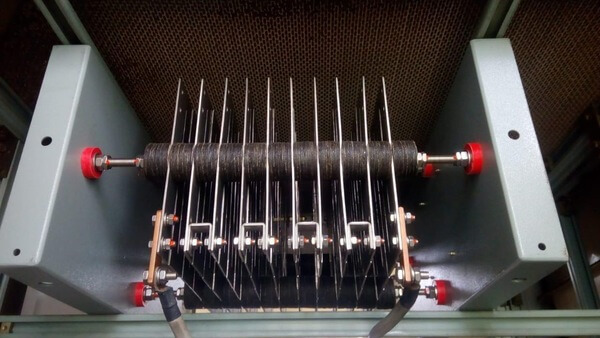 |
| Description | Three phase induction motors at the hydroelectric power plant generate huge inrush current during start-up time that can potentially damage their stator coils. The resistor is used to prevent this damage. |
| Features | Resistive Element: Stainless Steel punched grid Rated Voltage: 1.5KV Current Rating: 4000A for 0.2sec |
| Power Conversion in Solar converter panel @ a major MNC OEM | |
|---|---|
| Resistor used | Damping Resistor from KWK Resistors |
| Type | SS Punched Grid type resistor assembly |
| Application | Being used by Power Conversion in Solar converter panel |
| Image | 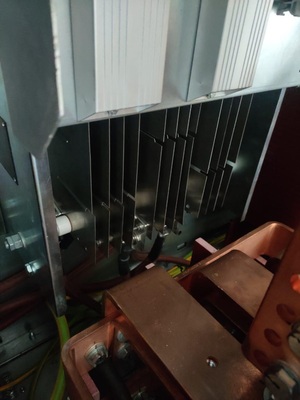 |
| Description | In Power Electronic Inverter the resistor is connected between Power Grid and PWM Output Filter. This resistor will handle the High harmonic voltage & Peak Surge Current from Grid. |
| Features | Resistive Element: Stainless Steel punched grid Surge Voltage : 1.75kV Surge Current Rating: 3800A |


